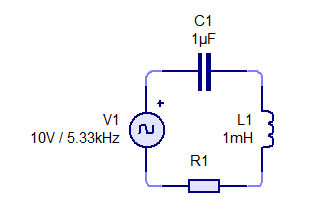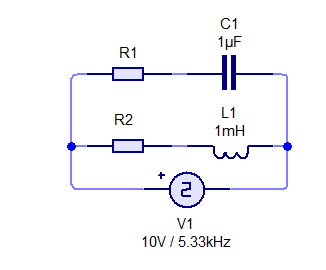Become a member of our Forum, and gain access to a lot more information!
Resonance in a Resistive (R), Inductive (L), Capacitive (C), termed as and RLC Circuit, commonly known as an LC Circuit, can be calculated as a function of the fore mentioned values.
The Resistive Term (R) is the Impedance (Z) of the RLC Resonance Circuit, which is a combination of the Reactances (X), Inductive Reactance (XL), and Capacitive Reactance (XC), the Imaginary Resistance (j), and the DC Resistance (R).
In a Parallel Resonant, or a Series Resonant Inductor (l), Capacitor (C), circuit, there will be a resonance at the Frequency (f), determined by the equation: f = 1 / 2 PI Sqt(L C)
Where:
Note: Damping Factors, Zeta (ζ) can shift this frequency.
The resonance of a series RLC circuit occurs when the Inductive Reactance, XL, and Capacitive Reactance, XC, are equal in magnitude, but because they are 180 degrees out of phase, cancel each other.
The Resistance, R1 is the ESR, Equivalent Circuit Resistance of the Circuit. Hence: Z = R + J XL + -XC, where the term: XL + -XC approaches Zero at resonance, thus: Z = R + J
The Resistance is considered to be only the DC Resistance of the Circuit at Resonance as the Reactive Components Cancel each other. This means there is no Reactance (X) component, and the Impedance (Z) is only made up of the DC Resistance (R), and the Imaginary Resistance (j).
For more information, I would recommend: Series Resonance Circuit

At Resonance, the Impedance (Z) of the Parallel Resonant Circuit is at its Maximum Value, where the Impedance (Z) of the circuit is now the combined Reactance (X), Inductive Reactance (XL), and Capacitive Reactance (XC), the Imaginary Resistance (j), plus the DC Resistance.
The Resistances, R1 is the Capacitive Reactance (XC), and R2 is the Inductive Reactance (XL), which is the ESR, Equivalent Circuit Resistance of the Circuit. Hence: Z = R + j X, as Resonance is reached, Reactance (X) will head toward Infinity!
This means the Circuit will have an ever increasing Impedance (Z) as it gets closer to Resonance!
For more information, I would recommend: Parallel Resonance Circuit
